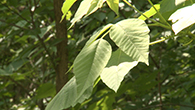Kansas State University horticulturist explains how to avoid poison ivy
Monday, June 2, 2014
MANHATTAN — You may have heard the phrase "leaves of three, let it be" when it comes to detecting poison ivy. Kansas State University horticulturists say it is a bit more complicated than that.
"The leaves of poison ivy can have a smooth edge or a coarsely toothed edge, or even a lobed edge," said Ward Upham, university extension agent in horticulture. "There are many different forms the leaves can take, so you need to look at other aspects of the plant."
Poison ivy also grows in many different forms. You can find it covering the ground, in a shrub or climbing up a tree.
Charlie Barden, Kansas State University forestry extension specialist, says poison ivy is often confused with other plants like Virginia creeper, fragrant sumac and box elder. He says there are three key identifiers to look for if you want to avoid taking home an unwanted souvenir this summer.
• The middle leaf of the poison ivy plant is on a longer stem than the other two leaves.
• The two outside leaves are attached directly to the main stem.
• The branch holding the poison ivy is brown, not green.
More than 90 percent of people are allergic to poison ivy, and it often takes 10 to 12 hours before the symptoms show.
"A poison ivy rash is different from a bug bite because it will start out just being red and irritated and then blisters will actually raise up," Barden said. "People say those blisters will spread and believe they are spreading the oil, but the spreading is just because it takes awhile for the reaction to occur."
Remedies are available for this pesky plant. One lotion on the market that contains clay particles can be applied before you go into the woods and will prevent the poison ivy rash from occurring.
Getting rid of the plant on your property also is a preventative step. Upham says to consider grubbing, where you remove the plant from the ground after it has rained. He recommends using an herbicide containing Triclopyr, which will be labeled as a brush killer. If the poison ivy is climbing up a tree, cut down the ivy, then apply the herbicide to the stump of the poison ivy.
If you can't get rid of the plant, it is best to avoid it altogether.

